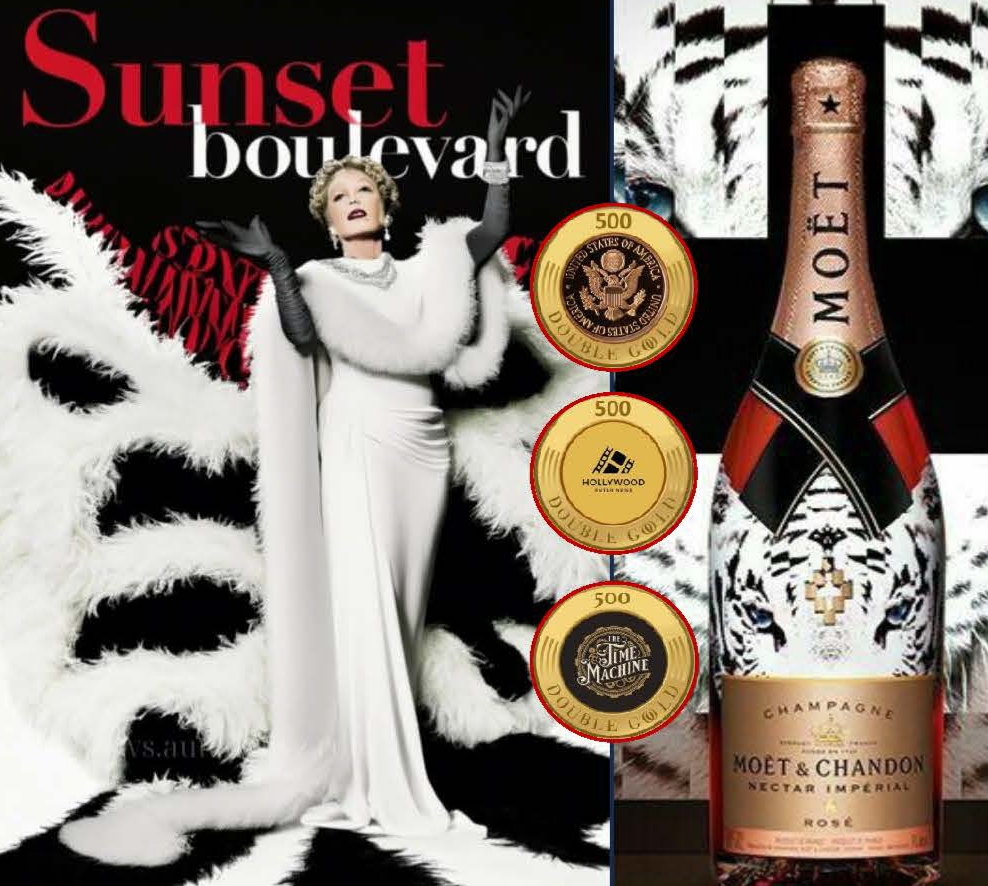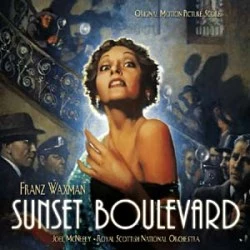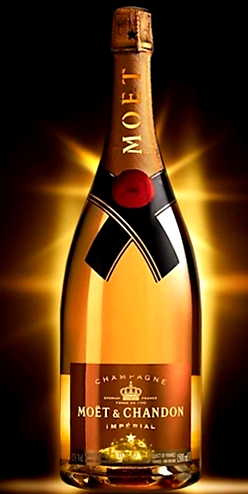Description
Sunset Boulevard is a 1950 American dark comedy film noir directed by Billy Wilder and co-written by Wilder, Charles Brackett and D. M. Marshman Jr. It is named after a major street that runs through Hollywood.
The film stars William Holden as Joe Gillis, a struggling screenwriter, and Gloria Swanson as Norma Desmond, a former silent-film star who draws him into her deranged fantasy world, where she dreams of making a triumphant return to the screen. Erich von Stroheim plays Max von Mayerling, her devoted butler, and Nancy Olson, Jack Webb, Lloyd Gough, and Fred Clark appear in supporting roles. Director Cecil B. DeMille and gossip columnist Hedda Hopper play themselves, and the film includes cameo appearances by silent-film stars Buster Keaton, H. B. Warner, and Anna Q. Nilsson.
Praised by many critics when first released, Sunset Boulevard was nominated for 11 Academy Awards (including nominations in all four acting categories) and won three. It is often ranked among the greatest movies ever made. As it was deemed « culturally, historically,
or aesthetically significant » by the U.S. Library of Congress in 1989, Sunset Boulevard was included in the first group of films selected for preservation in the National Film Registry.
In 1998, it was ranked number 12 on the American Film Institute‘s list of the 100 best American films of the 20th century. In 2007, it was 16th on their 10th Anniversary list.
At a mansion on Sunset Boulevard, police officers and photographers discover the body of Joe Gillis floating face down in the swimming pool. In a flashback, Joe relates the events leading to his death.
Six months earlier, Joe, a down-on-his-luck screenwriter, tries to interest Paramount Pictures in a story he submitted. Script reader Betty Schaefer harshly critiques it, unaware that Joe is listening. Later, while fleeing from repo men seeking his car, Joe turns into the driveway of a seemingly deserted mansion inhabited by forgotten silent film star Norma Desmond.
Learning that Joe is a writer, Norma asks his opinion of a script she has written for a film about Salome. She plans to play the role herself in her return to the screen. Joe finds her script abysmal but flatters her into hiring him as a script doctor.
Joe moves into Norma’s mansion at her insistence and sees that Norma refuses to believe that her fame has evaporated. Her butler, Max, secretly writes all of the fan mail she receives in order to maintain the illusion.
At her New Year’s Eve party, Joe realizes that she has fallen in love with him. He tries to let her down gently, but Norma slaps him and retreats to her room, distraught. Joe visits his friend Artie Green and again meets Betty, who thinks a scene in one of Joe’s scripts has potential. When he phones Max to have him pack his things, Max tells him Norma has cut her wrists with his razor. Joe then returns to Norma, and their relationship becomes sexual.
Norma has Max deliver the edited Salome script to her former director Cecil B. DeMille at Paramount. She starts getting calls from Paramount executive Gordon Cole but refuses to speak to anyone except DeMille. Eventually, she has Max drive her and Joe to Paramount in her 1929 Isotta Fraschini. DeMille welcomes her affectionately and treats her with great respect but tactfully evades her questions about the script. Max then learns that Cole only called her because he wants to rent her Isotta Fraschini for use in a film.
Preparing for her imagined comeback, Norma undergoes rigorous beauty treatments. Joe secretly works nights in Betty’s office, collaborating on an original screenplay, and she eventually confesses she has fallen for him. After learning of Joe’s moonlighting, Max reveals he was once a respected film director who discovered Norma, made her a star, and became her first husband. Following their divorce, he abandoned his career to become her servant.
Norma discovers a manuscript with Joe and Betty’s names on it and phones Betty, insinuating that Joe is not the man he seems. Overhearing the call, Joe invites Betty to the mansion to see for herself. When she arrives, he pretends that he is satisfied being a gigolo so that she can be with Artie. However, after she tearfully leaves, he packs to return to his old newspaper job in Dayton, Ohio. He bluntly informs Norma that there will be no comeback, that Max writes all of her fan mail, and that she has been forgotten, though Max refuses to break her delusions. Joe disregards Norma’s threat to kill herself as she brandishes a gun; as he leaves the house, Norma shoots him three times, and he collapses into the pool.
The flashback ends, and the film returns to the present day, with Norma about to be arrested for murder. The mansion is overrun with police and reporters with newsreel cameras, which she believes are film cameras. Max pretends to « direct » her, and the police play along. As the cameras roll, Norma descends the grand staircase. Upon reaching the bottom, she stops and makes an impromptu speech about how happy she is to be making a film again. She then says, « Alright, Mr. DeMille, I’m ready for my close-up. » and approaches the camera.
Production
The street known as Sunset Boulevard has been associated with Hollywood film production since 1911, when the town’s first film studio, Nestor, opened there. The film workers lived modestly in the growing neighborhood, but during the 1920s, profits and salaries rose to unprecedented levels. With the advent of the star system, luxurious homes noted for their often incongruous grandeur were built in the area.
As a young man living in Berlin in the 1920s, Billy Wilder was interested in American culture, with much of his interest fueled by the country’s films. In the late 1940s, many of the grand Hollywood houses remained, and Wilder, then a Los Angeles resident, found them to be a part of his everyday world. Many former stars from the silent era still lived in them, although most were no longer involved in the film business. Wilder wondered how they spent their time now that « the parade had passed them by » and began imagining the story of a star who had lost her celebrity and box-office appeal.
The character of Norma Desmond mirrors aspects of the twilight years of several real-life faded silent-film stars, such as the reclusive existences of Mary Pickford and Pola Negri and the mental disorders of Mae Murray, Valeska Surratt, Audrey Munson and Clara Bow. Dave Kehr has asserted that Norma Talmadge is « the obvious if unacknowledged source of Norma Desmond, the grotesque, predatory silent movie queen » of the film. The most common analysis of the character’s name is that it is a combination of the names of silent film actress Mabel Normand and director William Desmond Taylor, a close friend of Normand’s who was murdered in 1922 in a never-solved case sensationalized by the press.
Writing
Cinematographer John Seitz stated that Wilder « had wanted to do Evelyn Waugh‘s 1948 novel The Loved One, but couldn’t obtain the rights. » Waugh’s story follows a failed screenwriter who lives with a silent film star and works in a cemetery. Gossip columnist Hedda Hopper, who plays herself in the movie, wrote that « Billy Wilder … was crazy about Evelyn Waugh’s book The Loved One, and the studio wanted to buy it. » Regardless, the plans for this adaptation fell through.
The original script that followed nevertheless contains similarities to the novel. At one point, Norma mistakes Joe for a funeral director and inquires about a coffin for herself and her deceased pet chimp.
Wilder and Brackett began working on a script in 1948, but the result did not completely satisfy them. In August 1948, D. M. Marshman Jr., formerly a writer for Life, was hired to help develop the storyline after Wilder and Brackett were impressed by a critique he provided of their film The Emperor Waltz (1948).
In an effort to keep the full details of the story from Paramount Pictures and avoid the restrictive censorship of the Breen Code, they submitted the script a few pages at a time.
The Breen Office insisted certain lines be rewritten, such as Gillis’s « I’m up that creek and I need a job, » which became « I’m over a barrel. I need a job. » Paramount executives thought Wilder was adapting a story called A Can of Beans (which did not exist) and allowed him relative freedom to proceed as he saw fit. Only the first third of the script was written when filming began in early May 1949, and Wilder was unsure how the film would end.











Avis
Il n’y a pas encore d’avis.